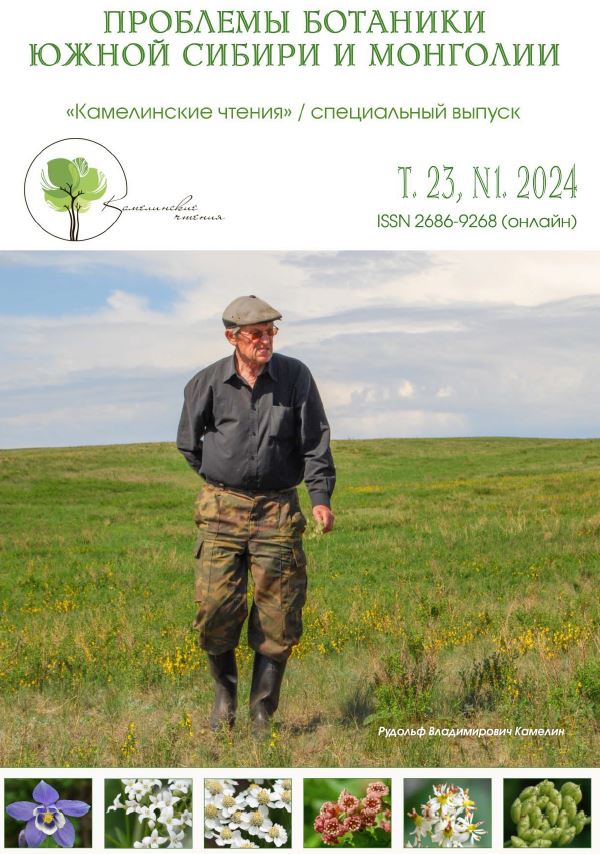Lichens of the Tura Khan and Khusain Bek mausoleums (Republic of Bashkortostan, Chishminsky District)
УДК 582.291(476)
Abstract
The mausoleums of Tura Khan and Khusain Bek are architectural monuments of the 14th century, located in the Chishminsky district of the Bashkortostan Republic The lichens’ species composition on the external surface of walls and domes was identified as part of the biodistruction studying project in the summer of 2023. Thirty two lichen species were found on such substrates as limestone, sandstone, gypsum, lime mortar, concrete and mosses. The most common species found in mausoleums are Calogaya decipiens (Arnold) Arup et al., Caloplaca saxicola (Hoffm.) Nordin, Candelariella sp., Diplotomma venustum Korb., Phaeophyscia nigricans (Florke) Moberg, Verrucaria sp. The species of the genera Phaeophyscia Moberg, Physcia (Schreb.) Michx., Myriolecis Clem. and the Physciaceae Zahlbr., Teloschistaceae Zahlbr. families are most diverse. Lichens cover a significant part of the surface of the mausoleums, which characterizes the condition of the monuments as moderate biological destruction. All species found are widespread and typical of carbonate substrates of anthropogenic communities. They do not require protection and can be removed from the surface of the mausoleums if such a need arises during restoration.
Downloads
Metrics
References
Власов А. Д., Нестеров Е. М. Биологическая колонизация фасадов исторических зданий Санкт-Петербурга. Методы исследования // Науки о земле и цивилизация. - СПб.: Изд-во РГПУ им. А. И. Герцена, 2019. - С. 58-60.
Гагарина Л. В. Лихенофлора городов Пермь, Чердынь и Кунгур (Пермский край, Урал) // Вестник Санкт-Петербург. госуд. ун-та, 2007. - Т. 3, № 3. - С. 31-39.
Ныпорко С. А., Редченко А. А. Мохообразные и лишайники - биодеструкторы исторических памятников Львовщины (Украина) // Проблемы и перспективы развития: Матер. III международ. науч.-практ. конф. «Урбоэко-системы», 2008. - С. 130-134.
Панова Е. Г., Власов А. Д., Попова Т. А., Зеленская М. С., Власов Д. Ю. Биологическое выветривание гранита в условиях городской среды // Биосфера, 2015. - Т. 7, №1. - С. 61-79.
Пчёлкин А. В. Метод усиления теневого контраста для оценки воздействия на субстрат эпилитных лишайников // Экологический мониторинг и моделирование экосистем, 2022. - Т. 33, № 1-2. - С. 90-107. DOI: 10.21513/02072564-2022- 1-2-90-107
Список лихенофлоры России. - СПб.: Наука, 2010. - 194 с.
Юсупов Г. В. Введение в булгаро-татарскую эпиграфику. - М.; Л.: Изд. АН СССР, 1960. - 204 с.
Юматов В. С. Древние памятники на земле башкирцев Чубиминской волости // Оренбургские губернские ведомости, 1848. - №1, 2, 4 ,7, 9.
Cozzolino A., Adamo P., Bonanomi G., Motti R. The Role of Lichens, Mosses, and Vascular Plants in the Biodeterioration of Historic Buildings: A Review // Plants, 2022. - Vol. 11, № 3429 - 19 p. DOI: 10.3390/ plants11243429
Salvadori O., Municchia A. C. The Role of Fungi and Lichens in the Biodeterioration of Stone Monuments // The Open Conference Proceedings Journal, 2016. - Vol. 7. DOI: 10.2174/2210289201607020039
Stepanchikova I. S., Himelbrant D. E., Konoreva L. A. The lichens and allied fungi of the Gladyshevskiy Protected Area (Saint Petersburg) // Novosti Sist. Nizsh. Rast., 2014. - Vol. 48. - P. 291-314.
WestbergM., Moberg R., Myrdal M., Nordin A., Ekman S. Santesson’s Checklist of Fennoscandian Lichen-Forming and Lichenicolous Fungi. - Museum of Evolution, Uppsala University, 2021. - 933 p.



